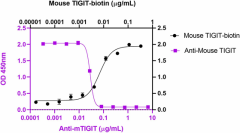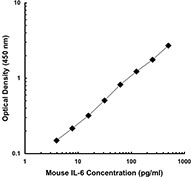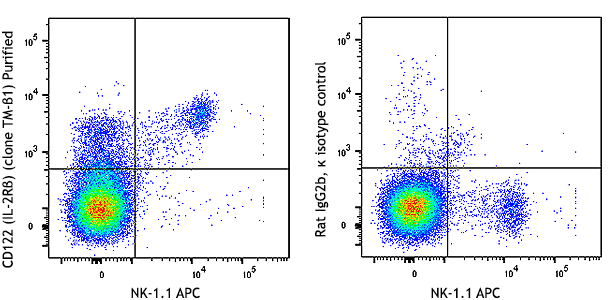- Clone
- A17200C (See other available formats)
- Regulatory Status
- RUO
- Other Names
- T-Cell Immunoreceptor with Ig and ITIM domains, T cell Ig, Immunoglobulin Domain-Containing Protein 9, V-Set, Transmembrane Domain-Containing Protein 3, WUCAM
- Isotype
- Rat IgG2a, κ
- Ave. Rating
- Submit a Review
- Product Citations
- publications

-

Recombinant biotinylated mouse TIGIT (Black Circles) binds to immobilized recombinant mouse CD155/PVR. Ultra-LEAF™ Purified anti-mouse TIGIT (Vstm3) Antibody, clone A17200C (Purple squares) inhibits the binding in a dose-dependent manner whereas the isotype control (Cat. No. 400562, not shown) does not have the effect. This antibody blocks the binding of 0.04 µg/mL biotinylated recombinant mouse TIGIT to 1 µg/mL of immobilized recombinant mouse CD155 with an ND50 = 0.01 - 0.06 µg/mL.
| Cat # | Size | Price | Save |
|---|---|---|---|
| 622203 | 100 µg | ¥44,820 | |
| 622204 | 1 mg | ¥118,690 |
TIGIT (T cell immunoreceptor with Ig and ITIM domains precursor) contains an immunoglobulin variable domain, a transmembrane domain and an immunoreceptor tyrosine-based inhibitory motif. TIGIT is an inhibitory receptor expressed on the surface of natural killer (NK) cells. TIGIT recognizes nectin and nectin-like adhesion molecules and thus plays a critical role in the innate immune response to malignant transformation. TIGIT in conjunction with CD226 forms a pathway that has prominent similarities to the costimulatory CD28/CTLA-4 pathway. CD226 and TIGIT bind the same set of ligands (CD155 and CD112) and CD226 is a positive regulator of T cell responses, while TIGIT inhibits them. Knockdown of TIGIT expression in human CD4+ T cells results in an increase of both T-bet and IFN-γ mRNA and protein expression. These effects are overcome by blocking CD226 signaling indicating that TIGIT exerts immunosuppressive effects by competing with CD226 for the same ligand, CD155. The binding of CD155 to TIGIT on human dendritic cells enhances the production of interleukin 10 and diminishes the production of interleukin 12p40. TIGIT shows an inhibitory effect on cell-signaling pathway in murine models of experimental autoimmune encephalomyelitis (EAE). Loss of TIGIT expression in mice results in hyperproliferative T cell responses and increased susceptibility to EAE.
Product DetailsProduct Details
- Verified Reactivity
- Mouse
- Antibody Type
- Monoclonal
- Host Species
- Rat
- Immunogen
- Mouse TIGIT Recombinant Protein
- Formulation
- 0.2 µm filtered in phosphate-buffered solution, pH 7.2, containing no preservative.
- Endotoxin Level
- Less than 0.01 EU/µg of the protein (< 0.001 ng/µg of the protein) as determined by the LAL test.
- Preparation
- The Ultra-LEAF™ (Low Endotoxin, Azide-Free) antibody was purified by affinity chromatography.
- Concentration
- The antibody is bottled at the concentration indicated on the vial, typically between 2 mg/mL and 3 mg/mL. Older lots may have also been bottled at 1 mg/mL. To obtain lot-specific concentration and expiration, please enter the lot number in our Certificate of Analysis online tool.
- Storage & Handling
- The antibody solution should be stored undiluted between 2°C and 8°C. This Ultra-LEAF™ solution contains no preservative; handle under aseptic conditions.
- Application
-
Block - Quality tested
- Recommended Usage
-
Each lot of this antibody is quality control tested by blocking the binding between mCD155 / PVR and mTIGIT. The ND50 range: 0.01 – 0.06 µg/mL. It is recommended that the reagent be titrated for optimal performance for each application.
- Product Citations
-
- RRID
-
AB_2814472 (BioLegend Cat. No. 622203)
AB_2814472 (BioLegend Cat. No. 622204)
Antigen Details
- Structure
- Homodimer
- Distribution
-
Human follicular B helper T cells (TFH), regulatory, memory and activated T cells, NK cells.
- Function
- Immunosuppressive effects by binding CD155 and modulating cytokine production by DC. Inhibits NK cell cytotoxicity. Inhibits T cell functions by competing with CD226. Tregs TIGIT+ cells suppress proinflammatory Th1 and Th17 cells, but not Th2 cell responses.
- Interaction
- Dendritic cells, monocytes
- Ligand/Receptor
- Poliovirus receptor (PVR/CD155) and nectin-2 (PRR-2/CD112)
- Cell Type
- NK cells, T cells
- Biology Area
- Cell Adhesion, Cell Biology, Immunology, Signal Transduction
- Molecular Family
- Adhesion Molecules, Immune Checkpoint Receptors, Soluble Receptors
- Antigen References
-
- Yu X, et al. 2009. Nat. Immunol. 10:48.
- Stanietsky N, et al. 2009. Proc. Natl. Acad. Sci. U S A. 106:17858.
- Joller N, et al. 2011. J. Immunol. 186:1338.
- Tahara-Hanaoka S, et al. 2004. Int. Immunol. 16:533.
- Lozano E, et al. 2012. J. Immunol. 188:3869.
- Joller N, et al. 2014. Immunity. 40:569.
- Deuss FA, et al. 2017. J. Biol. Chem. 292:11413.
- Gene ID
- 100043314 View all products for this Gene ID
- UniProt
- View information about TIGIT on UniProt.org
Related FAQs
- Do you guarantee that your antibodies are totally pathogen free?
-
BioLegend does not test for pathogens in-house aside from the GoInVivo™ product line. However, upon request, this can be tested on a custom basis with an outside, independent laboratory.
- Does BioLegend test each Ultra-LEAF™ antibody by functional assay?
-
No, BioLegend does not test Ultra-LEAF™ antibodies by functional assays unless otherwise indicated. Due to the possible complexities and variations of uses of biofunctional antibodies in different assays and because of the large product portfolio, BioLegend does not currently perform functional assays as a routine QC for the antibodies. However, we do provide references in which the antibodies were used for functional assays and we do perform QC to verify the specificity and quality of the antibody based on our strict specification criteria.
- Does BioLegend test each Ultra-LEAF™ antibody for potential pathogens?
-
No, BioLegend does not test for pathogens in-house unless otherwise indicated. However, we can recommend an outside vendor to perform this testing as needed.
- Have you tested this Ultra-LEAF™ antibody for in vivo or in vitro applications?
-
We don't test our antibodies for in vivo or in vitro applications unless otherwise indicated. Depending on the product, the TDS may describe literature supporting usage of a particular product for bioassay. It may be best to further consult the literature to find clone specific information.
Other Formats
View All TIGIT Reagents Request Custom Conjugation| Description | Clone | Applications |
|---|---|---|
| Ultra-LEAF™ Purified anti-mouse TIGIT (Vstm3) | A17200C | Block |
| PE anti-mouse TIGIT (Vstm3) | A17200C | FC |
| PE/Cyanine5 anti-mouse TIGIT (Vstm3) | A17200C | FC |
Customers Also Purchased
Compare Data Across All Formats
This data display is provided for general comparisons between formats.
Your actual data may vary due to variations in samples, target cells, instruments and their settings, staining conditions, and other factors.
If you need assistance with selecting the best format contact our expert technical support team.
-
Ultra-LEAF™ Purified anti-mouse TIGIT (Vstm3)

Recombinant biotinylated mouse TIGIT (Black Circles) binds t... -
PE anti-mouse TIGIT (Vstm3)

ConA-stimulated (3 days) C57BL/6 mouse splenocytes were stai... -
PE/Cyanine5 anti-mouse TIGIT (Vstm3)

ConA-stimulated C57BL/6 mouse splenocytes (3 days) were stai...











Follow Us